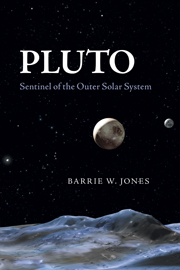Book contents
- Frontmatter
- Contents
- List of tables
- Preface
- Acknowledgements
- 1 The Solar System
- 2 The discovery of Uranus, Neptune and Pluto
- 3 Pluto: a diminishing world
- 4 Pluto's family
- 5 Surfaces, atmospheres and interiors of Pluto and Charon
- 6 The Edgeworth-Kuiper belt
- 7 Is Pluto a planet?
- 8 The New Horizons mission to Pluto (and beyond)
- 9 Pluto: gateway to beyond?
- Glossary
- Further reading and other resources
- Index
9 - Pluto: gateway to beyond?
Published online by Cambridge University Press: 05 December 2011
- Frontmatter
- Contents
- List of tables
- Preface
- Acknowledgements
- 1 The Solar System
- 2 The discovery of Uranus, Neptune and Pluto
- 3 Pluto: a diminishing world
- 4 Pluto's family
- 5 Surfaces, atmospheres and interiors of Pluto and Charon
- 6 The Edgeworth-Kuiper belt
- 7 Is Pluto a planet?
- 8 The New Horizons mission to Pluto (and beyond)
- 9 Pluto: gateway to beyond?
- Glossary
- Further reading and other resources
- Index
Summary
What would it be like to stand on Pluto: what would we see, what would we feel? Would Pluto be useful as a launch pad for spacecraft to go to other Kuiper belt objects, to the Oort cloud and even to the stars?
TO STAND ON PLUTO
The sky
The distances from Pluto to the stars are so very much greater than from Pluto to the Earth, that the same constellations will appear in Pluto's sky as in the Earth's sky, and the same Milky Way, all with the same relative brightnesses. The retrograde rotation of Pluto means that the stars will rise in the West and set in the East. The solar day on Pluto, as on the Earth, is the time between successive noons (at noon the Sun is at its maximum altitude). On Earth this interval is one (solar) day. Pluto's axial rotation period is longer than that of the Earth, and therefore the solar day is longer, 6.387 Earth days. The Sun, planets, and stars thus move considerably more slowly across Pluto's sky than across our skies.
The rotation axis on Earth is directed at a point in the northerly sky near the fairly bright star Polaris (the Pole Star), which is a little under 1° from the exact point around which the sky appears to rotate. On Pluto the corresponding point is about 15° East from the bright star Altair.
Information
- Type
- Chapter
- Information
- PlutoSentinel of the Outer Solar System, pp. 195 - 206Publisher: Cambridge University PressPrint publication year: 2010
